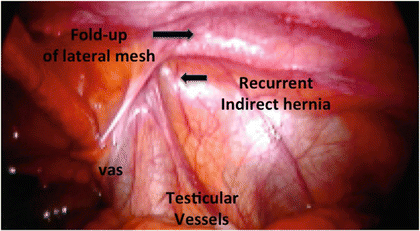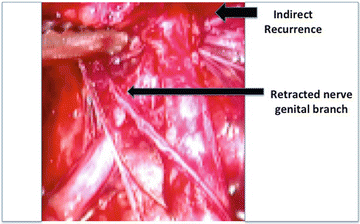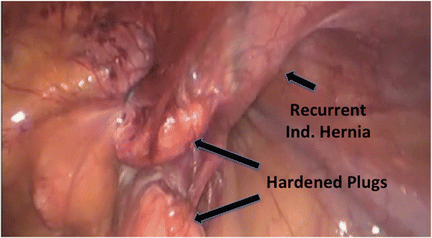Fig. 16.1.
The anatomy of posterior floor as viewed through a laparoscope. (a) Inferior epigastric vessels. (b) Genital branch of the genital–femoral nerve. (c) Genital–femoral nerve. (d) Lateral cutaneous nerve. (e) Indirect hernia defect. (f) Pubis with Cooper ligament. (g) Vas deferens. (h) Testicular vessels. (i) Iliopubic tract . (j) External iliac vessels.
The named nerves that are at risk for injury in the retroperitoneum from dissection during a posterior hernia repair or after the repair are the femoral nerve, genitofemoral nerve and its branches (femoral and genital), and the lateral cutaneous nerve. In most patients, the nerves run below the iliopubic tract. How to avoid these nerves has been well described by multiple authors [23–25], but, unfortunately, as previously mentioned, the location of the nerves is variable. In an excellent cadaver study [22], in as many as 25 % patients, the nerves are not out of harm’s way. They run above the iliopubic tract where they can be injured by dissection and anchoring hardware such as staples or tacks. In addition, anterior nerves that should not be at jeopardy for injury, on rare occasion, present within reach of posterior fixation of mesh. Cases have been reported of tacks penetrating the entire wall, injuring a superficial nerve.
Increasing the chance for chronic pain are idiopathic reactions to mesh that can result in irritation of any of the posterior nerves, including the obturator nerve, although it is well inferior but can be exposed during placement of the mesh. If the mesh bunches up or wrinkles, it may become thickened and hardened, acting as a potential pressure point on any of the nerves. The result will be chronic pain aggravated by activity or motion.
To summarize, nerve injury and chronic pain can be reduced by careful dissection and by being aware of where nerve injuries are most likely to occur. When mesh is fixed with anchors or mesh hardens, however, chronic pain can develop even after taking the proper precautions. Despite the potential for the development of chronic pain after posterior hernia repair, the incidence is quite low and in fact less than that after open inguinal hernia repair in randomized studies [15, 16].
Differential Diagnosis of Chronic Pain Following Posterior Hernia Repair
Pain after posterior inguinal hernia repair can be divided into acute and chronic, lasting more than 90 days. The etiology and treatment are usually quite different, and therefore one must be able to differentiate the two scenarios. Acute pain occurs from minutes to days after the repair. Except for severe unrelenting pain in the distribution of the femoral nerve, most pain arising within days after the surgery will slowly decrease and disappear. It is usually due to minor irritation of the posterior nerves from the surgical dissection, hematoma, or seroma. Anti-inflammatory medications and watchful waiting are the treatments of choice. If, however, pain is debilitating and in the distribution of a named nerve, such as the femoral nerve, injury to that nerve from a tack or staple should be suspected. Immediate re-exploration and removal of the offending anchor are required. If pain persists more than 3 months, it can be classified as chronic. Fortunately, this is uncommon, occurring in less than 4 % [26, 27] of patients undergoing laparoscopic posterior hernia repair.
Determining the etiology of a patient’s chronic pain after posterior repair is essential to guiding the treatment. The nature, timing, and location of the pain as well as inciting factors will help determine the cause and possible management. Several questions are important when determining the cause.
1.
When did the pain begin? Immediately after surgery, persisting, essentially unchanged, or did it begin weeks or months after the repair?
2.
Where is the pain located? Is it pinpoint or diffuse? Is it in the distribution of a single named nerve?
3.
What is the character of the pain?
4.
Is the pain elicited by any activity in particular?
Determining when and how the pain began helps determine the cause. If it develops soon after the operation, the cause was something that happened during the operation such as an injury of a nerve from a staple; if it develops months after the procedure, it is most likely a reaction to the mesh or even a recurrence of the hernia. If the offending agent is a staple, the pain usually begins soon after the repair and persists or worsens with time. Pain from a folded-up mesh begins much later and has a new onset.
The location of the pain guides the observer toward the proper nerve distribution. There is a fair amount of crossover, however, so location can be misleading. If the patient has pinpoint tenderness, it is usually in the location of the offending tack or staple used for fixation. This area should be marked prior to any exploration and will guide the surgeon at reoperation, as will be described later.
The type of pain may also help. Whether it is musculoskeletal or neuropathic. Finally, questioning the patient about activities that elicit or increase the pain may lead one to the correct location and precipitating event.
The workup should include a full history as just outlined and a complete exam of the area, including a directed palpation looking for recurrence and trigger points. Again, if a single point is found, it should marked prior to exploration. Ultrasounds, CT scans, and MRI have been reported to be helpful in looking for occult recurrence [28].
Treatment of Chronic Pain following Posterior Inguinal Hernia Repair
Unless postoperative pain is severe and occurring immediately after the procedure in the distribution of a major nerve as previously outlined, the patient should be observed and treated symptomatically. Because most postoperative pain will decrease and disappear over time, it is important that the surgeon explain that waiting 30–90 days is essential before more aggressive action is taken. The surgeon must explain that acting too early or invasively may do more harm to the patient than good. This time taken to talk with the patient to alleviate fears should prevent the patient from losing trust in the surgeon and prematurely seeking a second opinion. When the pain does not respond to conservative measures and becomes chronic, the next step should be an attempt at pain management with blocks by the surgeon or a pain management clinic. The exception would be when the pain can be easily localized and is most likely due to a single tack. Then laparoscopic exploration is indicated. The trigger site is marked just prior to laparoscopic exploration, and at laparoscopy the mark is palpated to guide removal of the corresponding tack or staple.
If conservative measures, medications, and therapeutic injections fail, laparoscopic re-exploration is the next step in treating chronic pain. If CT or ultrasound suggests a recurrence or other pathology as the cause of the pain, treatment is straightforward at the time of re-exploration. Because a positive preoperative study may be the exception, a complete laparoscopic exploration of the previous repair is necessary. The surgeon should approach the previous repair using a transabdominal laparoscopic approach (TAPP) . The first step is to look for intraperitoneal pathology that might be causing the patient’s pain (Fig. 16.2). The next step is to begin to open the peritoneum above the repair away from the mesh in a virgin area. If the mesh is flat and in the proper position, it should be left alone. Tacks or staples should be removed if they are loose or appear to correspond to the distribution of pain. If the surgeon finds mesh rolled up or folded in on itself, it should be removed. Pressure on sensory nerves from hardened mesh can result in chronic groin pain, especially related to activity and change in position. Removal, however, can be difficult. In some cases, the careful use of cautery is required to cut the mesh away from the wall. A careful search for recurrence of the original hernia or a missed hernia completes the exploration (Fig. 16.3). It is not unusual to find a defect that was missed by preoperative radiographic studies. If a recurrence is found to be the cause, it should be repaired with the addition of new mesh. If recurrence is associated with bunched-up, hardened mesh (Fig. 16.4), the surgeon should consider removing the mesh and delaying repair of the recurrence. A recurrent hernia can be repaired from an anterior approach after the patient recovers from the laparoscopic exploration. This staged approach better defines the etiology of the pain and leads to fewer long-term problems and less confusion.




Fig. 16.2.
Lateral fold-up of mesh with an indirect recurrent hernia in a patient with groin pain.

Fig. 16.3.
The dissected anatomy of the patient with rolled-up mesh demonstrating the indirect recurrence and the position of the genital branch of the genital–femoral nerve.

Fig. 16.4.



The laparoscopic view in a patient with severe groin pain reveals two hardened plugs with a recurrent indirect hernia. The plugs were removed using cautery and a flat mesh was placed to repair the recurrence.

Full access? Get Clinical Tree





